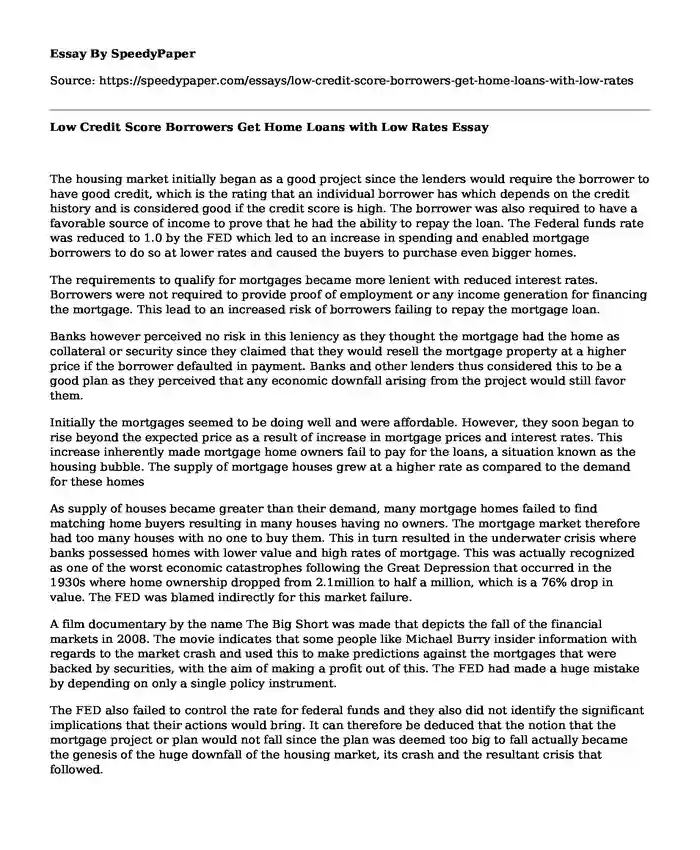
| Type of paper: | Case study |
| Categories: | United States Economics Finance |
| Pages: | 2 |
| Wordcount: | 535 words |
The housing market initially began as a good project since the lenders would require the borrower to have good credit, which is the rating that an individual borrower has which depends on the credit history and is considered good if the credit score is high. The borrower was also required to have a favorable source of income to prove that he had the ability to repay the loan. The Federal funds rate was reduced to 1.0 by the FED which led to an increase in spending and enabled mortgage borrowers to do so at lower rates and caused the buyers to purchase even bigger homes.
The requirements to qualify for mortgages became more lenient with reduced interest rates. Borrowers were not required to provide proof of employment or any income generation for financing the mortgage. This lead to an increased risk of borrowers failing to repay the mortgage loan.
Banks however perceived no risk in this leniency as they thought the mortgage had the home as collateral or security since they claimed that they would resell the mortgage property at a higher price if the borrower defaulted in payment. Banks and other lenders thus considered this to be a good plan as they perceived that any economic downfall arising from the project would still favor them.
Initially the mortgages seemed to be doing well and were affordable. However, they soon began to rise beyond the expected price as a result of increase in mortgage prices and interest rates. This increase inherently made mortgage home owners fail to pay for the loans, a situation known as the housing bubble. The supply of mortgage houses grew at a higher rate as compared to the demand for these homes
As supply of houses became greater than their demand, many mortgage homes failed to find matching home buyers resulting in many houses having no owners. The mortgage market therefore had too many houses with no one to buy them. This in turn resulted in the underwater crisis where banks possessed homes with lower value and high rates of mortgage. This was actually recognized as one of the worst economic catastrophes following the Great Depression that occurred in the 1930s where home ownership dropped from 2.1million to half a million, which is a 76% drop in value. The FED was blamed indirectly for this market failure.
A film documentary by the name The Big Short was made that depicts the fall of the financial markets in 2008. The movie indicates that some people like Michael Burry insider information with regards to the market crash and used this to make predictions against the mortgages that were backed by securities, with the aim of making a profit out of this. The FED had made a huge mistake by depending on only a single policy instrument.
The FED also failed to control the rate for federal funds and they also did not identify the significant implications that their actions would bring. It can therefore be deduced that the notion that the mortgage project or plan would not fall since the plan was deemed too big to fall actually became the genesis of the huge downfall of the housing market, its crash and the resultant crisis that followed.
Cite this page
Low Credit Score Borrowers Get Home Loans with Low Rates. (2022, Dec 27). Retrieved from https://speedypaper.com/essays/low-credit-score-borrowers-get-home-loans-with-low-rates
Request Removal
If you are the original author of this essay and no longer wish to have it published on the SpeedyPaper website, please click below to request its removal:
- Critical Essay Sample of the Movie The Wailing
- Free Essay Sample on The Licensing Act of 1662
- What is Bitcoin? Get the Answer from This Essay Example
- Personal and Professional Goals - Application Essay Example
- Essay Example about Fundraising and Resource Development
- Essay Sample Focusing on the Future of Tourism in Hawaii
- Essay Example - Risk and Security Assessment
Popular categories




